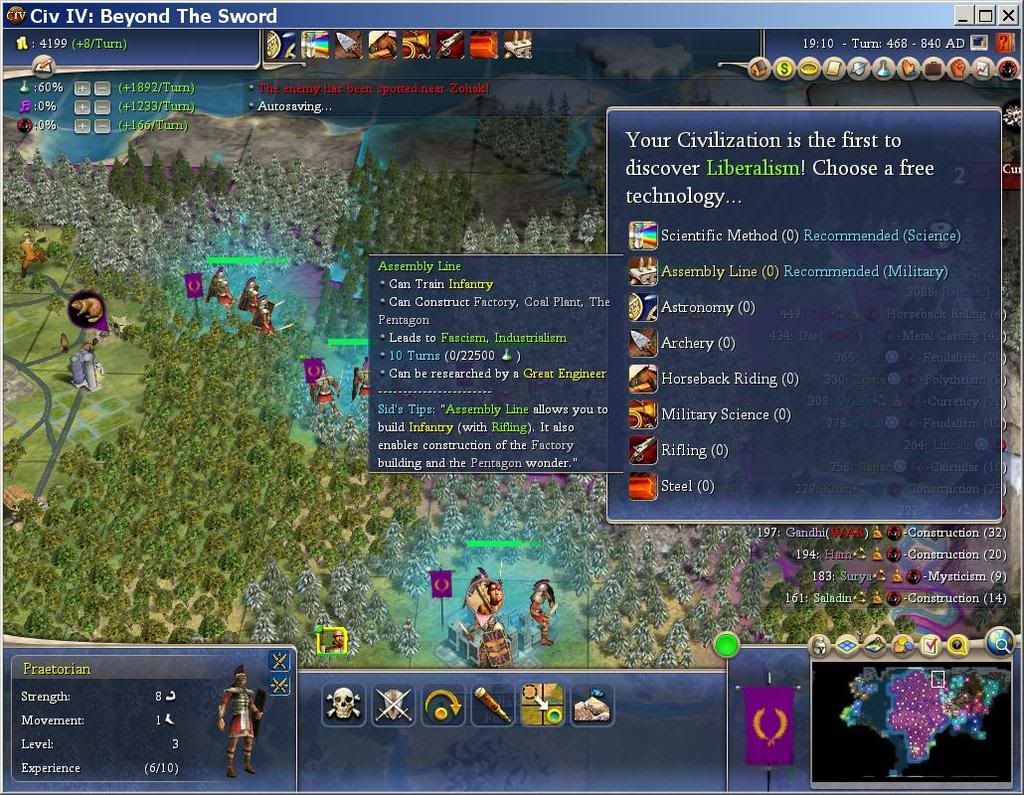Hey guys.
I've been toying around with getting the highest score possible, and playing under a controlled environment on the Earth map. I've been following VirusMonster's Guide to 500K+ scores through Huge map domination on Immortal difficulty guide to aid me. While I'm not yet trying this on Immortal, I do have a nice game going on Prince.
In my previous game, a Noble game, I was able to get 31 Cities at 10BC with Augustus Caesar, but my Economy was in some trouble:
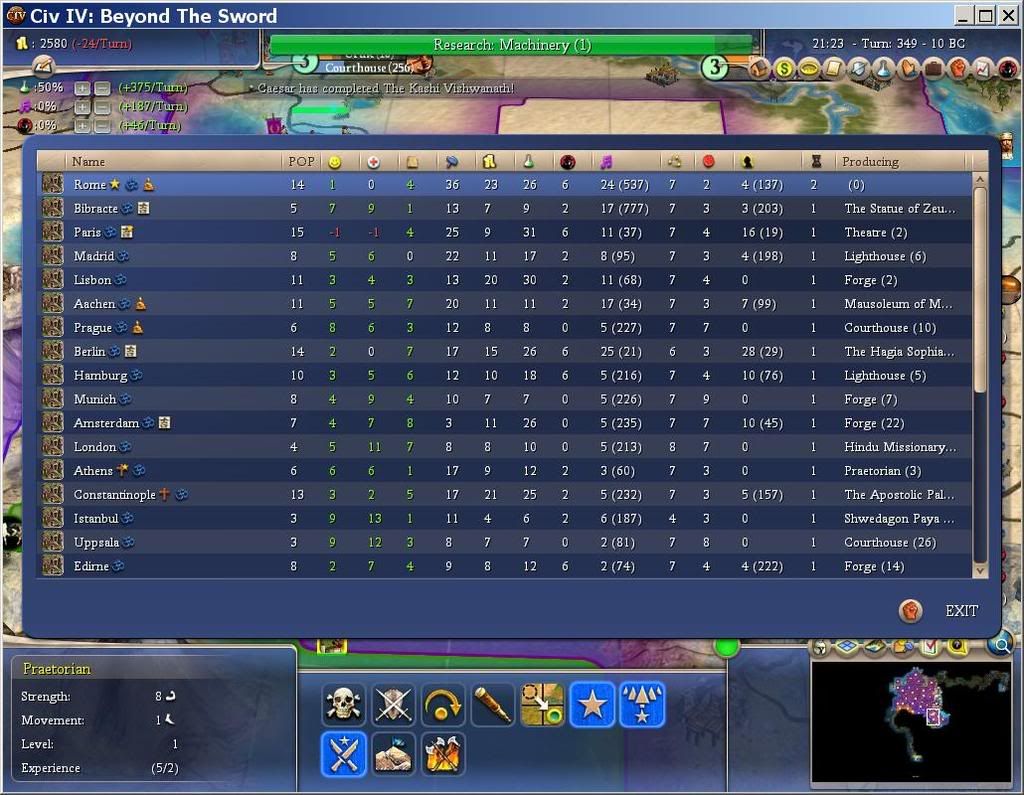
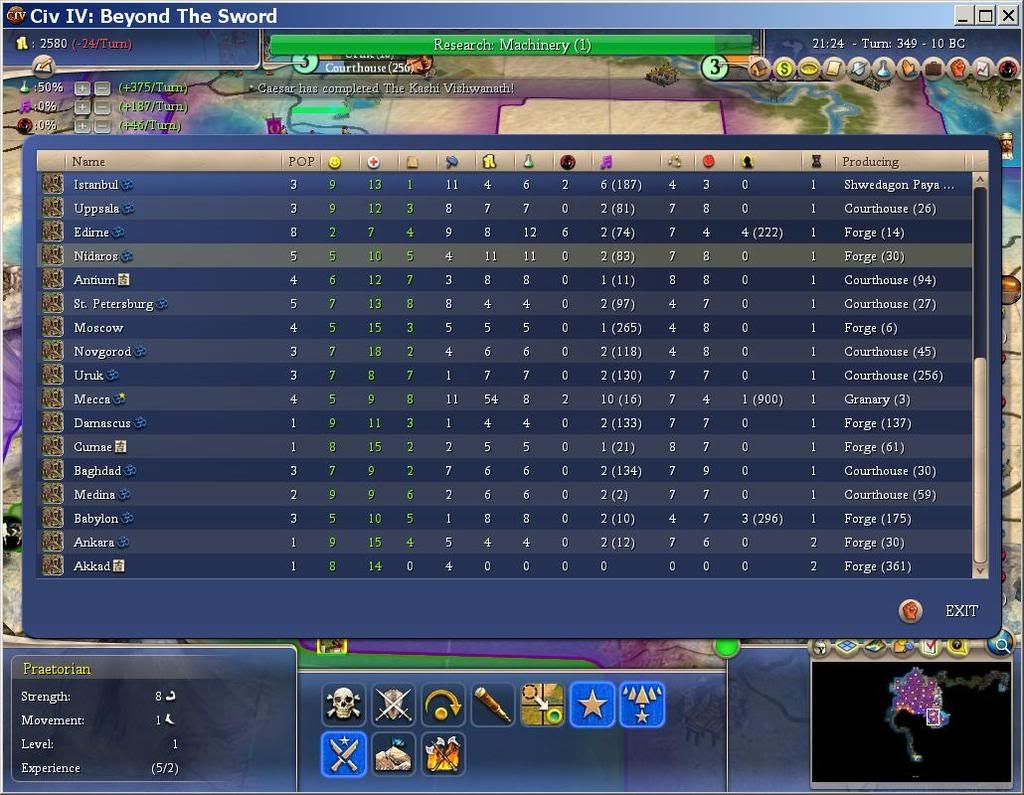
In my current game, it is 10BC and I have 44 cities with a very stable economy. Here are some pictures:
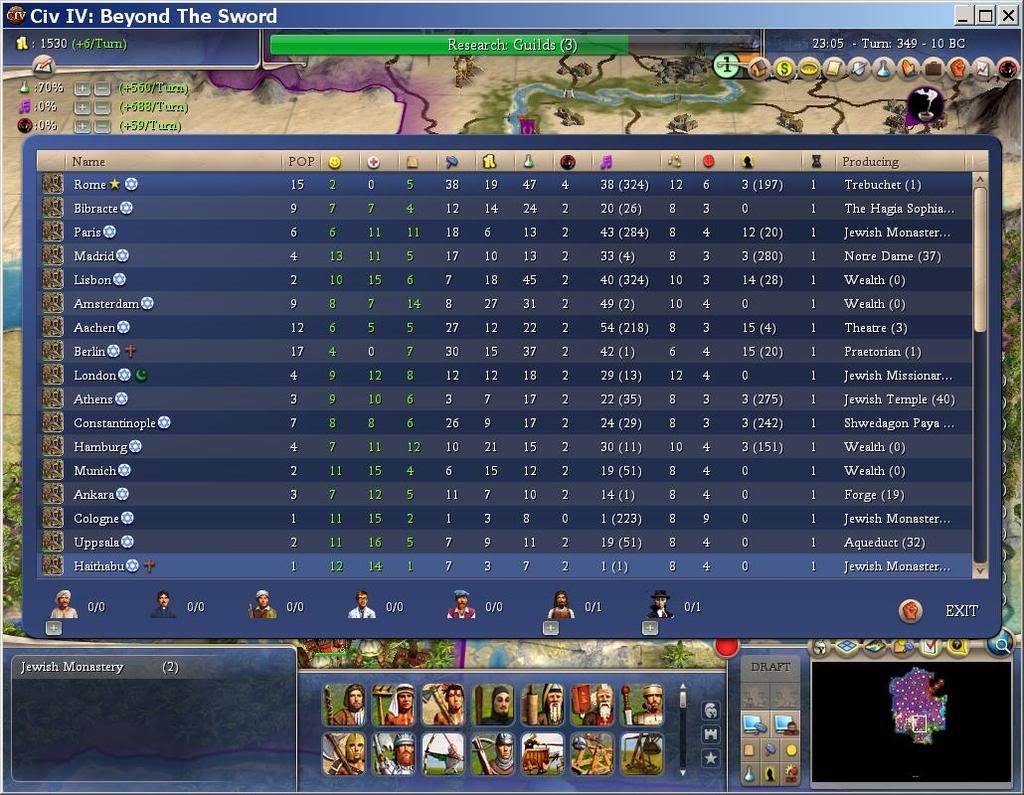
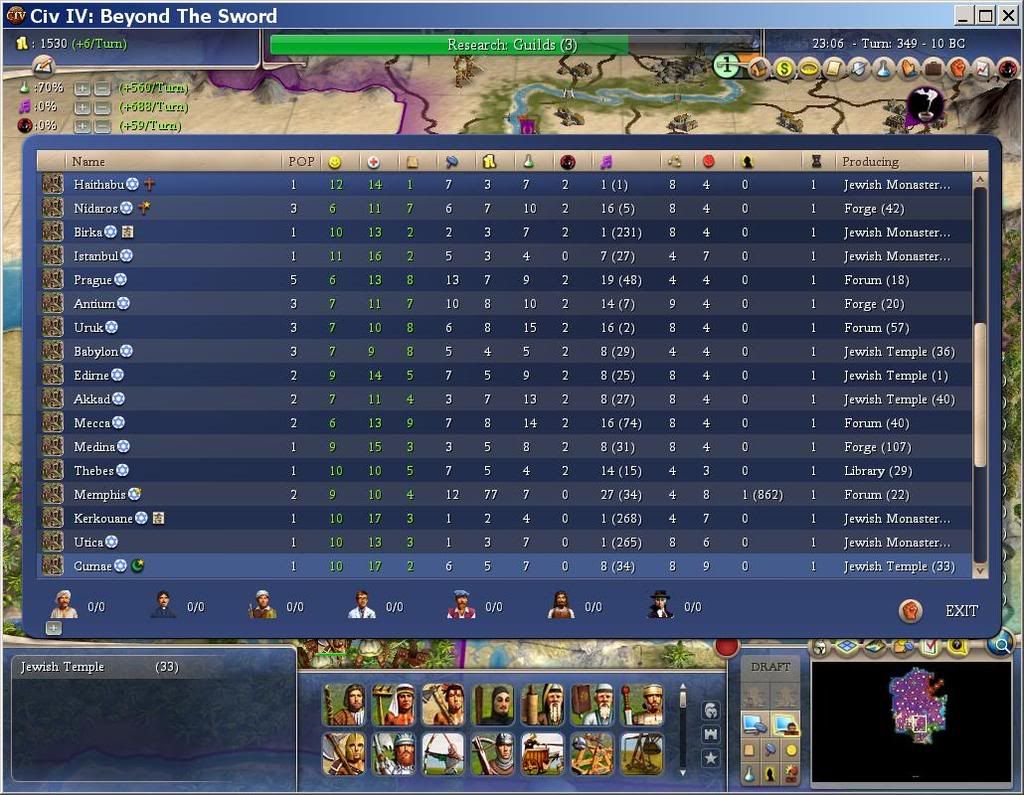
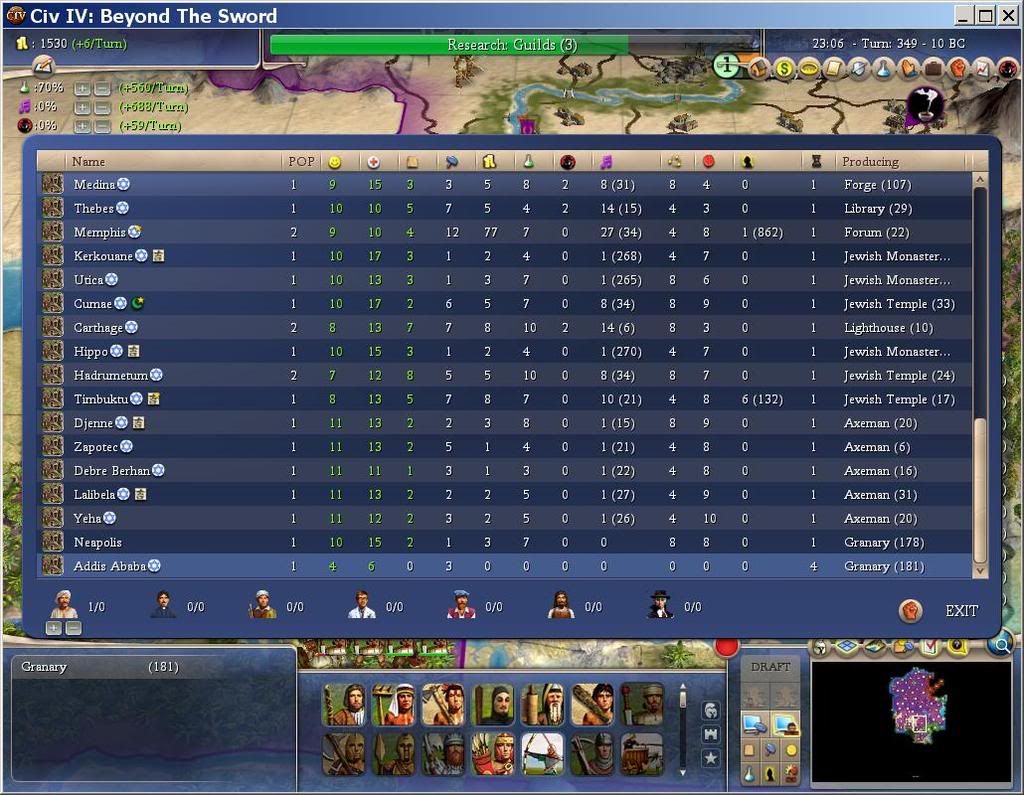
I have stacked the odds in my favor a bit. I am still not using the .17 patch, this lets me using a 34 civ mod. (I know that the .19 unoffical patch permits 50 civs, but I don't think there is an Earth scenario out for it yet. Though I may just make one here soon.) I also have no tech brokering toggled; while I won't be doing much trading, the AIs will. This slows them down a bit. Also, I have no city razing on. And one last thing, at the suggestion of someone from these forums, I chose Julius Caesar for the Organized trait instead of Augustus Caesar who has Industrious. Both Caesars have Imperalistic. The mod came with Augustus as the only leader choice for Rome, but I modded in Julius in lieu of Augustus for his Organized trait.
Lets recap the things that are stacked in my favor:
I've been asked how I manage such a large empire so well, and I'm going to attempt to answer that with two words:
Religious Economy
A Religious Economy works unlike many others that people are used to. In a Religious Economy, you do not convert commerce into gold, instead you turn religious icons into gold!
In the Prince game above, I am making a profit of 6 gold at 70% science putting forth a whopping 560 science per turn. However if you look at the pictures above, you'll see that many cities are producing a fair amount of gold each, and once city (Memphis) is producing a large amount of gold.
Each Jewish Temple produces: +1 happy, +2 hammers, +2 gold, +6 culture
Each Jewish Monastary produces: +10% science, +2 hammers, +2 gold, +7 culture
Each Jewish Synagogue (Cathedral) produces: +3 happy, +2 hammers, +2 gold, +5 culture, +50% culture
These are very worthwhile buildings to my empire. With the exception of the Cathedral, even the smallest of cities can be whipped to build these buildings in very little time.
The gold produced from these buildings comes from the Spiral Minaret (available with Divine Right.) In fact, I got Divine Right before Machinery (thusly Before Engineering) because I knew how important it would be. I forget the exact turn I built the Spiral Minaret, but when I did, it took my at-the-time-economy from 40% Gold at a net loss of 54 gold to 40% Gold at a net gain of 54 gold. That's right, 108 gold from one building!


The production from these buildings comes from The Apostolic Palace. One really neat feature about The Apostolic Palace is that you don't need to build this building to receive the hammer bonuses, however I find it important that you do build it because you can ensure that it falls under YOUR chosen religion. In this game, it's Judea.
Now lets take a look at Memphis, my holy city:
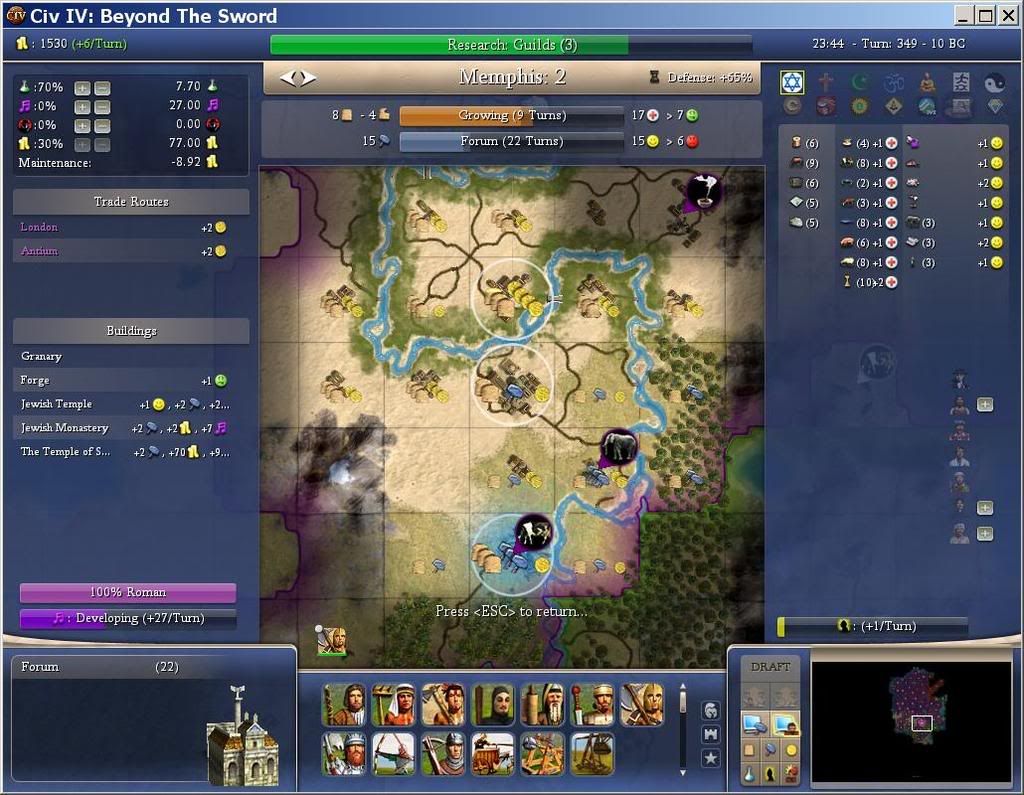
This is where another major other part of my economy comes from. This tiny city is producing 77 gold per turn! That's because the temple of Solomon (Jewish shrine) was built here.
Side Note: The shrine is considered a "Jewish building" thus receives the Apostolic Palace +2 hammer bonus, as well. I'm pretty sure it receives the +2 gold bonus from the Spiral Minaret, too. That means that my +70 gold is from 68 Jewish cities and +2 gold from the Spiral Minaret. A tiny amount, but still, 2 gold is 2 gold.
This city currently does NOT have a Forum (Roman Market) in it. Once I put that Forum in it, that 77 gold turns into 77*1.25 = 96.25 gold per turn! Also, Guilds is coming up very shortly. That means another 25% from a Grocer, or 77*1.50 = 115.50 gold per turn.
Also, Guilds is coming up very shortly. That means another 25% from a Grocer, or 77*1.50 = 115.50 gold per turn. 

Running Representation means each Specialist nets me +3 science. With such a huge empire, running anything other than Mercantilism would be silly. Banking is immedately following Guilds which will do two things. First, let me build a bank in Memphis. With a Forum, Grocer, and Bank, that's +100%, or 77*2.00=154 gold per turn!


Eventually my wall street will go there, but that's the very distant future.
The second thing that Banking does is Mercantilism. Fourty-four cities * three beakers per city equals 132 beakers per turn, if I choose to run ordinary citizens, sans bonuses. However virtually every city has a temple in it, meaning I can run a Priest Specialist in (almost) every city. For the sake af easy math, I'm going to assume every city will choose to run a Priest Specialist as their Free Specialist.
Each Priest Specialist net me 1 hammer, 1 gold, and 3 science.
Fourty-Four Priest Specialists net me 44 hammers, 44 gold, 132 beakers.
Chances are I'll have a Monestary in each city, that's 132*1.10, or 145.2 beakers per turn.
Currently each 10% gold change is a 64 gold and 72 science change. This means that once I swap to Mercantilism, I'll be able to run at almost 10% higher science output, while gaining a TON of science from the representation bonus. Added together that's 72+132, or a(n almost) 204 increase in Science from a simple civic change. My current science is 560, and 204 is 36% of 560. So I, in essence, gain about 1/3 more science from such a change.
Note: I will lose my foreign trade routes, however those are not very important to me, as with having so many cities under my control, I will have plenty of trade routes to go around, as well as I will actually be hurting the AI by denying them all these trade routes.
I am also not factoring in Libraries, which many cities have, but some also do not. Nor am I factoring in the change from Barbarism to Vassalage (Low to High) and the Decentralization to Mercantilism (Low to Medium) civic upkeeps. I figure I'll gain somewhere between 25% and 33% increase when all is said an done.
The last part of my economy is something I just figured out, and I'm slapping my forhead going "Duh!" for just figuring it out. This is not part of the religious economy, but rather what I'm going to call "Proper city managment."
Larger cities means more maintiance. Smaller cities means less maintiance. We all know this, yet I never thought to whip my cities into submission to keep the maintiance down. I was always worried about individual city performance that after I could support it, I'd let my cities grow to size 7, 10, 12, whatever they could grow to. And let them slowly trudge away building two or three buildings on the way to these super huge cities. What a mistake! With an empire this large, my capitol which has zero distance maintiance, has a 6 gold maintiance from "Number of cities!" That means every city I have has a 6 gold maintiance from the number of cities! (-50% if I have a courthouse) That's 6 gold maintiance from every city, or 6*44=264 gold maintiance, not including the distance penalty! This means courthouses are especially important.
By whipping everything everytime I can, I am keeping my cities small thusly I reduce the city distance maintiance, which is influenced by city size, AND build more important buildings faster. The more important buildings are: Monasteries, Temples, and Courthouses.
I check every city every turn to see if it can whip. This means each turn can take many minutes. Once, when I was doing a whole lot of micromanaging, it took me over 30 minutes to make two turns. I can just hear TheMeInTeam crying right about now. For those that don't know, TheMeInTeam is a big fan of fast games, games that last only a few hours. Where as I have games that last 20, 30, ever 40 hours long that span over weeks of playtime!
For those that don't know, TheMeInTeam is a big fan of fast games, games that last only a few hours. Where as I have games that last 20, 30, ever 40 hours long that span over weeks of playtime!
My build order has been like this:
Yes, I am making each city build its own defensive units. The rest of my empire is far too busy doing other things to be distracted with babysitting new cities. Although, maybe if I dedicated one city to producing defensive units, I could speed up the process at which newer cities "come on line." Hmm, perhaps I'll have to explore that for the future.
In my Noble game, I had eventually 5 or 6 cities manufacturing 5exp (or greater) units upon completion. However, I was leaving my 5exp Praetorans as Garrison duty. The idea was to tech to Assembly Line, promote my existing army so I could keep my City Raider points, and then when I manufactured more fresh Infantry, replace my garrisoned Praetorians with the fresh Infantry, promote them to City Raider 2, then upgrade them to Ifantry. This proved to be far too tedious for me, and I am attacking the situation differently in my new game.
Currently in my Prince game I lowered it down to two military cities. I may ad a 3rd eventually, but I'm not sure about that yet. In the two military cities I do have, there are 2 GGs settled in each city. With a Barracks, that's +7 exp, and Vassalage is coming soon for another +2. Soon I will have +9 out the gate. (Almost Level 4!) I then leave one (usually unpromoted) Praetorian in the newly captured city while it produces a defensive unit. I got the shock random event, so I've been using Axemen if the cities have been connected to my trade network, or Archers if not. I only just got Feudalism, so I may switch over to Longbowmen all together. I haven't quite decided yet.
I found that by leaving one Praet for garrison duty in newly captured cities, and only moving it out once I have a fresh defensive unit, I need to produce far fewer Praetorians from my military cities, and increasing the overall effectiveness of my army. Also, this has let me reduce the military cities virtually in half, permitting stronger (currently 7 exp) units out the gate. In future games I may try to have one "defensive unit" city that doesn't have any settled great generals, but produces units for the freshly captured cities.
Anyways, that's how I'm doing it! It hasn't been without mistakes. I misestimated how quickly my 2nd military city would be up to speed, and settled not only my 2nd but me 3rd Great Genaral in that city...When I could have been pumping out 7 (or even 9) exp units from my 1st military city (Rome.) Oops! Live and learn. I've also made some silly mistakes by not worker chasing when I'm about to kill a civ. Now I've been moving units around cities before capturing the last one, to herd the workers into the city so I can capture them. The extra 2 turns before capturing the city is well worth it, in my opinion, as workers are becoming more and more necessary as my empire is rapidly expanding.
I've also made some silly mistakes by not worker chasing when I'm about to kill a civ. Now I've been moving units around cities before capturing the last one, to herd the workers into the city so I can capture them. The extra 2 turns before capturing the city is well worth it, in my opinion, as workers are becoming more and more necessary as my empire is rapidly expanding.
If you have any questions, just ask!
I've been toying around with getting the highest score possible, and playing under a controlled environment on the Earth map. I've been following VirusMonster's Guide to 500K+ scores through Huge map domination on Immortal difficulty guide to aid me. While I'm not yet trying this on Immortal, I do have a nice game going on Prince.
In my previous game, a Noble game, I was able to get 31 Cities at 10BC with Augustus Caesar, but my Economy was in some trouble:
Spoiler :


In my current game, it is 10BC and I have 44 cities with a very stable economy. Here are some pictures:
Spoiler :



I have stacked the odds in my favor a bit. I am still not using the .17 patch, this lets me using a 34 civ mod. (I know that the .19 unoffical patch permits 50 civs, but I don't think there is an Earth scenario out for it yet. Though I may just make one here soon.) I also have no tech brokering toggled; while I won't be doing much trading, the AIs will. This slows them down a bit. Also, I have no city razing on. And one last thing, at the suggestion of someone from these forums, I chose Julius Caesar for the Organized trait instead of Augustus Caesar who has Industrious. Both Caesars have Imperalistic. The mod came with Augustus as the only leader choice for Rome, but I modded in Julius in lieu of Augustus for his Organized trait.
Lets recap the things that are stacked in my favor:
- 34 Civ mod
- No Tech brokering
- No city razing
- Julius Caesar
- Julius Caesar
I've been asked how I manage such a large empire so well, and I'm going to attempt to answer that with two words:
Religious Economy
A Religious Economy works unlike many others that people are used to. In a Religious Economy, you do not convert commerce into gold, instead you turn religious icons into gold!
In the Prince game above, I am making a profit of 6 gold at 70% science putting forth a whopping 560 science per turn. However if you look at the pictures above, you'll see that many cities are producing a fair amount of gold each, and once city (Memphis) is producing a large amount of gold.
Each Jewish Temple produces: +1 happy, +2 hammers, +2 gold, +6 culture
Each Jewish Monastary produces: +10% science, +2 hammers, +2 gold, +7 culture
Each Jewish Synagogue (Cathedral) produces: +3 happy, +2 hammers, +2 gold, +5 culture, +50% culture
These are very worthwhile buildings to my empire. With the exception of the Cathedral, even the smallest of cities can be whipped to build these buildings in very little time.
The gold produced from these buildings comes from the Spiral Minaret (available with Divine Right.) In fact, I got Divine Right before Machinery (thusly Before Engineering) because I knew how important it would be. I forget the exact turn I built the Spiral Minaret, but when I did, it took my at-the-time-economy from 40% Gold at a net loss of 54 gold to 40% Gold at a net gain of 54 gold. That's right, 108 gold from one building!



The production from these buildings comes from The Apostolic Palace. One really neat feature about The Apostolic Palace is that you don't need to build this building to receive the hammer bonuses, however I find it important that you do build it because you can ensure that it falls under YOUR chosen religion. In this game, it's Judea.
Now lets take a look at Memphis, my holy city:
Spoiler :

This is where another major other part of my economy comes from. This tiny city is producing 77 gold per turn! That's because the temple of Solomon (Jewish shrine) was built here.
Side Note: The shrine is considered a "Jewish building" thus receives the Apostolic Palace +2 hammer bonus, as well. I'm pretty sure it receives the +2 gold bonus from the Spiral Minaret, too. That means that my +70 gold is from 68 Jewish cities and +2 gold from the Spiral Minaret. A tiny amount, but still, 2 gold is 2 gold.
This city currently does NOT have a Forum (Roman Market) in it. Once I put that Forum in it, that 77 gold turns into 77*1.25 = 96.25 gold per turn!
 Also, Guilds is coming up very shortly. That means another 25% from a Grocer, or 77*1.50 = 115.50 gold per turn.
Also, Guilds is coming up very shortly. That means another 25% from a Grocer, or 77*1.50 = 115.50 gold per turn. 

Running Representation means each Specialist nets me +3 science. With such a huge empire, running anything other than Mercantilism would be silly. Banking is immedately following Guilds which will do two things. First, let me build a bank in Memphis. With a Forum, Grocer, and Bank, that's +100%, or 77*2.00=154 gold per turn!



Eventually my wall street will go there, but that's the very distant future.
The second thing that Banking does is Mercantilism. Fourty-four cities * three beakers per city equals 132 beakers per turn, if I choose to run ordinary citizens, sans bonuses. However virtually every city has a temple in it, meaning I can run a Priest Specialist in (almost) every city. For the sake af easy math, I'm going to assume every city will choose to run a Priest Specialist as their Free Specialist.
Each Priest Specialist net me 1 hammer, 1 gold, and 3 science.
Fourty-Four Priest Specialists net me 44 hammers, 44 gold, 132 beakers.
Chances are I'll have a Monestary in each city, that's 132*1.10, or 145.2 beakers per turn.
Currently each 10% gold change is a 64 gold and 72 science change. This means that once I swap to Mercantilism, I'll be able to run at almost 10% higher science output, while gaining a TON of science from the representation bonus. Added together that's 72+132, or a(n almost) 204 increase in Science from a simple civic change. My current science is 560, and 204 is 36% of 560. So I, in essence, gain about 1/3 more science from such a change.
Note: I will lose my foreign trade routes, however those are not very important to me, as with having so many cities under my control, I will have plenty of trade routes to go around, as well as I will actually be hurting the AI by denying them all these trade routes.
I am also not factoring in Libraries, which many cities have, but some also do not. Nor am I factoring in the change from Barbarism to Vassalage (Low to High) and the Decentralization to Mercantilism (Low to Medium) civic upkeeps. I figure I'll gain somewhere between 25% and 33% increase when all is said an done.
The last part of my economy is something I just figured out, and I'm slapping my forhead going "Duh!" for just figuring it out. This is not part of the religious economy, but rather what I'm going to call "Proper city managment."
Larger cities means more maintiance. Smaller cities means less maintiance. We all know this, yet I never thought to whip my cities into submission to keep the maintiance down. I was always worried about individual city performance that after I could support it, I'd let my cities grow to size 7, 10, 12, whatever they could grow to. And let them slowly trudge away building two or three buildings on the way to these super huge cities. What a mistake! With an empire this large, my capitol which has zero distance maintiance, has a 6 gold maintiance from "Number of cities!" That means every city I have has a 6 gold maintiance from the number of cities! (-50% if I have a courthouse) That's 6 gold maintiance from every city, or 6*44=264 gold maintiance, not including the distance penalty! This means courthouses are especially important.
By whipping everything everytime I can, I am keeping my cities small thusly I reduce the city distance maintiance, which is influenced by city size, AND build more important buildings faster. The more important buildings are: Monasteries, Temples, and Courthouses.
I check every city every turn to see if it can whip. This means each turn can take many minutes. Once, when I was doing a whole lot of micromanaging, it took me over 30 minutes to make two turns. I can just hear TheMeInTeam crying right about now.
 For those that don't know, TheMeInTeam is a big fan of fast games, games that last only a few hours. Where as I have games that last 20, 30, ever 40 hours long that span over weeks of playtime!
For those that don't know, TheMeInTeam is a big fan of fast games, games that last only a few hours. Where as I have games that last 20, 30, ever 40 hours long that span over weeks of playtime!My build order has been like this:
- Defensive unit
- Granary
- Monastary
- Temple
- Forge
- Courthouse
- Forum (Market)
- Library
- Whatever~~
Yes, I am making each city build its own defensive units. The rest of my empire is far too busy doing other things to be distracted with babysitting new cities. Although, maybe if I dedicated one city to producing defensive units, I could speed up the process at which newer cities "come on line." Hmm, perhaps I'll have to explore that for the future.
In my Noble game, I had eventually 5 or 6 cities manufacturing 5exp (or greater) units upon completion. However, I was leaving my 5exp Praetorans as Garrison duty. The idea was to tech to Assembly Line, promote my existing army so I could keep my City Raider points, and then when I manufactured more fresh Infantry, replace my garrisoned Praetorians with the fresh Infantry, promote them to City Raider 2, then upgrade them to Ifantry. This proved to be far too tedious for me, and I am attacking the situation differently in my new game.
Currently in my Prince game I lowered it down to two military cities. I may ad a 3rd eventually, but I'm not sure about that yet. In the two military cities I do have, there are 2 GGs settled in each city. With a Barracks, that's +7 exp, and Vassalage is coming soon for another +2. Soon I will have +9 out the gate. (Almost Level 4!) I then leave one (usually unpromoted) Praetorian in the newly captured city while it produces a defensive unit. I got the shock random event, so I've been using Axemen if the cities have been connected to my trade network, or Archers if not. I only just got Feudalism, so I may switch over to Longbowmen all together. I haven't quite decided yet.
I found that by leaving one Praet for garrison duty in newly captured cities, and only moving it out once I have a fresh defensive unit, I need to produce far fewer Praetorians from my military cities, and increasing the overall effectiveness of my army. Also, this has let me reduce the military cities virtually in half, permitting stronger (currently 7 exp) units out the gate. In future games I may try to have one "defensive unit" city that doesn't have any settled great generals, but produces units for the freshly captured cities.
Anyways, that's how I'm doing it! It hasn't been without mistakes. I misestimated how quickly my 2nd military city would be up to speed, and settled not only my 2nd but me 3rd Great Genaral in that city...When I could have been pumping out 7 (or even 9) exp units from my 1st military city (Rome.) Oops! Live and learn.
 I've also made some silly mistakes by not worker chasing when I'm about to kill a civ. Now I've been moving units around cities before capturing the last one, to herd the workers into the city so I can capture them. The extra 2 turns before capturing the city is well worth it, in my opinion, as workers are becoming more and more necessary as my empire is rapidly expanding.
I've also made some silly mistakes by not worker chasing when I'm about to kill a civ. Now I've been moving units around cities before capturing the last one, to herd the workers into the city so I can capture them. The extra 2 turns before capturing the city is well worth it, in my opinion, as workers are becoming more and more necessary as my empire is rapidly expanding.If you have any questions, just ask!


 at micromanagement indeed
at micromanagement indeed  .
.